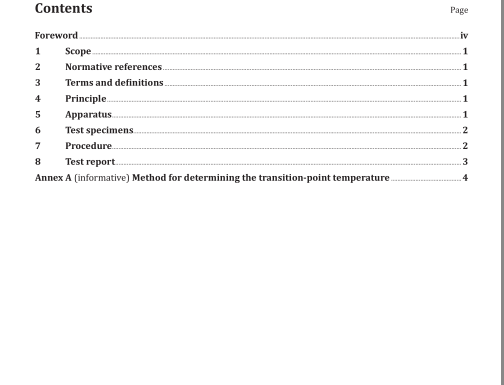BS ISO 16334:2013 pdf download.Monolithic refractory products — Determination of resistance to explosive spalling
This International Standard specifies a method for determining the resistance to explosive spalling of monolithic refractories.
2 Normative references
The following documents, in whole or in part, are normatively referenced in this document and are indispensable for its application. For dated references, only the edition cited applies. For undated references, the latest edition of the referenced document (including any amendments) applies.
ISO 836, Terminology for refractories
ISO 1927-5, Monolithic (unshaped) refractory products — Part 5: Preparation and treatment of test pieces 3 Terms and definitions
For the purposes of this document, the terms and definitions given in ISO 836 and the following apply.
3.1 transition-point temperature
indication of the dewaterability of the castable Note 1 to entry: A low transition-point temperature indicates high dewaterability and this directly relates to high explosion resistance. A castable having a high transition-point temperature indicates poor dewaterability and low explosion resistance. (See Annex A for further information.)
4 Principle
A test specimen is prepared by casting and allowed to cure. The specimen is then enclosed in an explosion-proof cage before being placed in a preheated kiln at a prescribed temperature.
NOTE The method has been developed as a practical way of measuring a property. It is not designed to form part of acceptance testing for monolithic products. Rather, it is more useful for comparative purposes. It is also useful for monolithic design purposes
5 Apparatus
5.1 Mould. A split cylindrical mould with internal dimensions of 80 mm height and 80 mm diameter and having a provision to allow for in situ casting of a thermocouple into the centre of the cast specimen.
5.2 Thermocouple. A thin wire thermocouple (preferably Type K). The thermocouple needs to be sufficiently insulated to withstand heating to test temperature inside and long enough to reach a temperature recorder located sufficient distance from the kiln to avoid damage.
5.3 Temperature recorder. Any instrument capable of recording the temperature of the thermocouple, either continuously or at short intervals to an accuracy of 1 °C.
5.4 Explosion-proof cage. A cube with approximate dimensions of 150 mm per side, constructed of stainless steel mesh, having at least 60 % openings, and one side able to be opened.
The construction should be strong enough to withstand explosion of the test specimen at the test temperature. 5.5 Kiln. Electric or gas, capable of restoring the kiln temperature to the required test temperature to within 5 °C, within 5 min after the test specimen is placed in the kiln. 5.6 Timing device. Any convenient timing device accurate to 1 s. 6 Test specimens The test specimen shall be prepared in accordance with ISO 1927-5, using the mould as described in 5.1. If information about transition-point temperature is required, a wire thermocouple shall be cast in situ into the centre of the test specimen. The test specimen dimensions shall be 80 mm diameter by 80 mm height, with each dimension accurate to 1 mm. Following casting, the test specimen shall be prevented from drying prior to testing by placing in a sealed plastic bag, or by other means as agreed between the interested parties. The curing temperature is 20 °C to 25 °C. 7 Procedure The procedure shall be as follows:
a) Prepare sufficient test specimens in accordance with Clause 6. The curing temperature is the subject of agreement between the interested parties. The specimens shall be tested as soon as practicable after a minimum of 24 h curing. Curing time should not exceed 28 h.
b) Heat the kiln (5.5) to 600 °C or to a higher temperature if agreed between the parties. The kiln shall be capable of restoring the kiln temperature to the required test temperature to within 5 °C, within 5 min after the test specimen is placed in the kiln. Soaking the kiln for 30 min at temperature prior to testing may assist with meeting this requirement.
c) Place an untested specimen inside the explosion-proof cage (5.4), oriented as-cast, and secure the cage door opening. If a temperature recorder is being used, connect the thermocouple to the recorder.
d) Place the cage inside the kiln and start the timer (5.6) (and the specimen temperature recorder, if a specimen thermocouple is used).
e) Record the time(s) at which any explosions are heard.
f) Leave the cage inside the kiln for 20 min as a safety precaution. After 20 min have elapsed, remove the cage from the kiln.
g) Remove the test specimen from the cage and record the condition of the specimen according to the following classification:
1) No damage: no damage to test specimen.
2) Damage: the sample is cracked or has sustained minor surface damage (popouts < 15 mm diameter)
3) Catastrophic damage: damage exceeding that described in item
g) 2).
h) At least two specimens shall be tested at each temperature. If the specimens are classified differently following the initial tests, further specimens may be tested at the same temperature.
i) At the conclusion of testing at each temperature, raise the kiln temperature by 100 °C.
NOTE Conditions noted after item
b) apply
j) Repeat steps
c) to i) until the specimen is deemed to have failed or the maximum required test temperature up to a maximum of 1 000 °C has been reached.BS ISO 16334 pdf download.ISO 16334-2013 pdf download
